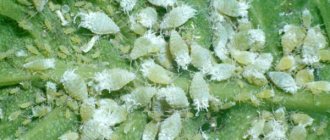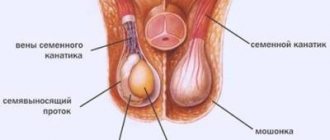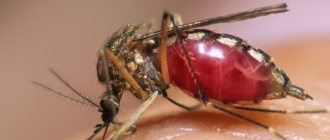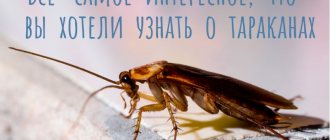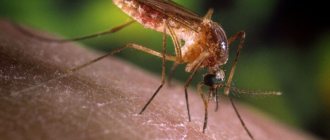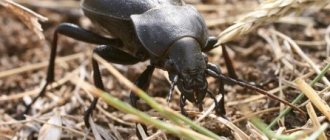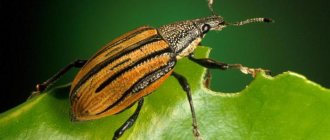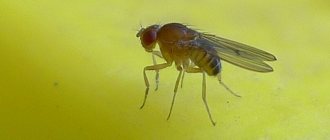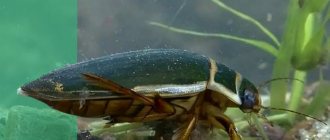Agrofak
The structure of the egg. An insect egg is a large cell, covered on the outside with a chorion, usually in the form of a shell, under which there is a true, or vitelline, membrane. The chorion is formed from the secretions of the epithelial cells of the oviduct of the ovary, and on its surface one can often find more or less strongly pronounced sculptured formations representing the imprints of follicular epithelial cells. On the surface of the chorion there is a hole - micropyle, which serves for the penetration of sperm.
The size of eggs in various insects varies within very wide limits - from 0.02-0.03 mm in phylloxera, some species of thrips and parasitic Hymenoptera to 11 mm in the saga grasshopper and even up to 15 mm in carpenter bees.
Types of eggs and the nature of their laying. In addition to size, eggs can differ in shape, chorion sculpture, and color. In shape they are often oval, elongated oval, or spherical. At the same time, in a number of cases the shape of the eggs is very typical for several species of the same genus, and often also a family. Thus, bottle-shaped eggs are very typical in cabbage and turnip whites, barrel-shaped in stink bugs, semi-spherical in cutworms, etc.
The outer surface of the eggs, i.e. the sculpture of the chorion, is often smooth, but may have longitudinal or transverse ribs, wrinkles, grooves, etc. Thus, in the eggs of moth butterflies, the chorion has radial ribs, in the eggs of cabbage and turnip whites - large longitudinal ones and small transverse ribs, eggs of some coccinellids have a fine-celled sculpture, etc.
The color of the chorion is usually one-color, milky white or yellow, but can be variegated and multi-colored. It often changes during the development of the embryo or when it is colonized by parasitic Hymenoptera.
Female insects lay large numbers of eggs in one or more batches. At the same time, they are placed one at a time, in small groups or in clutches of 100, 200 or more eggs, which is typical for this species. Thus, the cabbage whites lay eggs on the leaves of plants in clutches of up to 200 eggs each, and the turnip whites lay eggs one at a time.
Clutches of eggs can be laid openly on plants, for example in cabbage whites, ringed silkworms, coccinellids, or hidden in the substrate (soil, plant tissue), covered with hairs from the abdomen of the female, or protected from the outside by the walls of a leathery capsule. Thus, the clutches of eggs of the gypsy moth and lacewing are so tightly covered with hairs from the female’s abdomen that they are completely invisible from above, and the clutches of eggs of cockroaches and mantises are located inside a leathery capsule - an ooteca, formed by the frozen secretions of the female’s accessory glands. The egg capsules of locusts are also very unique, containing from 5-15 eggs in the atbasarka to 140 eggs in the desert locust. The secretion of the female accessory glands not only envelops them, but also cements adjacent soil particles.
Development of the embryo. Embryonic development begins with fragmentation of the nucleus and the movement of the resulting daughter nuclei with small areas of protoplasm to the periphery of the egg. Here they form a continuous layer of cells - the blastoderm, covering the accumulation of yolk. Subsequently, the blastoderm differentiates into embryonic and extra-embryonic zones. The cells of the germinal zone divide more intensively and form a germ band on the ventral side of the egg.
In the process of further differentiation of the germ band, its outer layer is formed - the ectoderm, which forms a two-layer fold at the edges, and the strip itself is somewhat immersed in the yolk. The growing edges of the fold close with each other and grow together, as a result of which the germ band is covered with two layers of cells - germinal membranes. The outer membrane is called serosa, the inner one is called amnion. Between the amnion and the developing embryo, a cavity is formed filled with a liquid that has protective and nutritional value for the embryo. The presence of shells explains the increased resistance of insect eggs after this stage of embryogenesis to insecticides, as well as to desiccation.
As the germ layers form, the insect embryo begins to form. The skin of the body is formed from the ectoderm; by invagination of the ectoderm from both poles, the oral and anal openings, the anterior and posterior sections of the intestine, and the rudiments of the future trachea and nervous system appear. The epithelium of the midgut is formed from the inner germ layer, the endoderm; the muscles, the fat body, the dorsal vessel, and the membrane of the gonads are formed from the middle mesoderm.
The formed embryo, which has essentially turned into a larva, fills the entire egg, begins to move intensively, draws air into the trachea, swallows amniotic fluid, increasing in volume, is freed from the embryonic membranes, breaks the chorion and hatches, i.e. comes out.
Typically, the embryonic development of insects lasts from 2 to 10 days, less often 2-3 weeks, depending mainly on the environmental temperature. With a long stop in development - embryonic diapause - the duration of the egg phase in some insects (locusts, flower flies, etc.) can reach 6-9 months.
| < Previous | Next > |
Types of insect development
Rice.
1. Development of an insect with incomplete transformation In insects, there are two main types of development, according to which they are divided into two large sections. Development with incomplete transformation
passes through three stages: egg - larva - imago (adult insect), not accompanied by sudden changes (
Fig. 1
). The larvae are similar in structure to adult insects and turn into them immediately after the end of development and the last molt.
Development with complete transformation
passes through four stages: egg - larva - pupa - adult. Larvae differ sharply from adults, therefore, having completed development, they turn into the resting pupal stage, in which the transformation of the body organization from larval to imaginal occurs.
Structure and types of larvae
The main functions of the larval stage are nutrition, growth, development. In the development of insects, the larva is the only growing stage. Its size can increase tens and hundreds of times. Therefore, the larvae molt several times, shedding the old cuticle in the form of a larval skin and at the same time forming a new one, designed for further growth.
Imaginous lines, or nymphs,
- insect larvae with incomplete metamorphosis. These larvae are similar in structure to adult insects. They have three pairs of well-developed legs on the thoracic region, compound eyes, a mouthpart similar to that of an imago, and well-developed antennae. They develop external wing rudiments. Typically, imago-like larvae are also similar to adults in their lifestyle and feeding pattern. In pests with incomplete transformation, larvae and adults always damage plants in a similar way. Some exceptions are the water-living larvae of dragonflies and mayflies, which have aquatic breathing organs - tracheal gills. They are sometimes called naiads.
Insect larvae with complete metamorphosis are sometimes called true
. These larvae may have a different number of limbs, which are less developed than those of adult insects; or limbs are missing. The larvae lack compound eyes; simple ocelli serve as visual organs. They lack external wing rudiments, the antennae are short or undeveloped, the oral apparatus is most often gnawing, and it can be of a completely different structure than that of the imago. Insect larvae with complete metamorphosis can differ sharply from the imago in their lifestyle and feeding pattern. In pests with complete metamorphosis, damage can be caused either by the larva or the imago, or by insects in both stages of development.
In insects with complete metamorphosis, three types of larvae are distinguished ( Fig. 3
).
Rice.
3. Types of insect larvae with complete transformation Campodeoid larvae
(from the Latin name of the primary wingless insect campodea, similar to representatives of this type) - active, often predatory, larvae with developed body appendages. They have well-developed three pairs of thoracic legs, fully articulated, their length usually exceeding the width of the body. The thoracic and abdominal sections are relatively clearly distinguished. Antennae are developed and large upper jaws are characteristic. The integument is usually pigmented. This type of larvae is found in some families of the order Coleoptera (ground beetles, rove beetles, ladybirds) and in all Reticulates.
Worm-like larvae
- a very large and heterogeneous group. Their body is elongated, weakly divided into thoracic and abdominal sections. Three pairs of thoracic legs are short or absent. Based on the presence of legs and the development of the head, three forms of worm-like larvae are distinguished. Larvae with heads and legs are found in insects of a number of families of the order Coleoptera and have a varied appearance. The larvae of Lamellar beetles (beetles and dung beetles) are thick, C-shaped; leaf beetle larvae are noticeably convex on top; The larvae of click beetles and darkling beetles (wireworms and pseudowireworms) are long, thin, cylindrical, with compacted integuments. Larvae with a head and without legs are also found in some representatives of the families of the order Coleoptera (beetles, longhorned beetles, weevils), in most groups of the order Hymenoptera (ichneumon fly, wasps, bees, ants) and in some species of the order Diptera (most mosquitoes). Only a number of representatives in the order Diptera (most flies) have larvae without legs and an outwardly defined head. The head section of these larvae is retracted into the prothorax, the head capsule is underdeveloped.
Caterpillar larvae
have an elongated body and a large number of short legs. Unlike other larvae, in addition to three pairs of thoracic legs, they have several pairs of accessory abdominal legs. These short, undivided larval appendages do not appear in adult insects. There are two forms of caterpillar larvae. True caterpillars - Lepidoptera larvae - have from 2 to 5 pairs of abdominal legs. The caterpillars of most butterflies have 5 pairs of legs located on the 3rd, 6th and 9th abdominal segments. However, in some families the number of abdominal legs is reduced to 4 (crested moths), 3 (metal moths) and 2 pairs (moths). False caterpillars are the larvae of some families of sawflies, representatives of the order Hymenoptera. They have a larger number of abdominal legs - 6-8 pairs.
Insect larvae with complete metamorphosis
In representatives of the order Lepidoptera, for example, in butterflies, they are called caterpillars and are very different from the adult individual. A larva emerges from the egg, gnawing through its shell and immediately begins to eat leaves and other parts of the plant with its powerful jaws - mandibles. Its body is worm-shaped, has a head, three thoracic and ten abdominal segments. The integument is equipped with hairs - bristles. Butterflies are insects that are characterized by complete transformation. On the lower lip of the larva there is a paired gland that secretes a secretion. When it hardens in air, it forms a thread, which the larva uses to form a cocoon. Remaining in it, the larva turns into a pupa. It can live from several weeks to one to three years, and the Volyanka pupa lives up to 10 years. Its body produces glycerin and betaine - natural antifreezes.
The larvae of butterflies - insects that have a complete metamorphosis - often molt. Their last molt ends with pupation. In some insect species, the larvae have separate names. For example, in sawfly beetles it is a false caterpillar, in pollen eaters and darkling beetles it is a false wireworm, dragonfly larvae are called naiads, and their prelarvae are called nymphs.
Structure and types of pupae
In insects with complete metamorphosis, the larva, having completed development, turns into a pupa. The larvae of most insects pupate in the soil, sometimes openly on or inside plants. Doll
- a resting stage, however, intense opposite processes take place in its body: the disintegration of larval organs and tissues and the formation of organs and tissues of the imago.
By the end of development, the pupa acquires the main structural features of an adult insect: developed wings, legs, antennae, adult mouthparts, compound eyes. The appendages are compactly folded and pressed to the body. The body is often covered with an additional protective shell. Based on this feature, three main types of pupae are distinguished ( Fig. 4
).
Rice.
4. Types of insect pupae Open
, or
free, pupae
do not have a shell; all appendages of the body are clearly visible and free. The similarity between the pupae and the imago is clearly evident. This type of pupae is found in the vast majority of Coleoptera and Hymenoptera, as well as in insects of the order Reticuloptera. Very rarely, open pupae are found in Lepidoptera and Diptera.
Covered pupae
have a thin, leathery, translucent shell through which legs, wings, antennae and other parts of the body can be distinguished. The shell is formed by secretions of the skin glands of the larva at the time of pupation. This type of pupae is characteristic of the vast majority of Lepidoptera, part of the order Diptera, and is very rarely found in Coleoptera and Hymenoptera.
Hidden pupae
enclosed in a dense opaque shell - puparia, through which it is impossible to distinguish body parts. This shell is a larval skin, which is not shed as usual during pupation, but only peels off from the body and serves as a protective cover. The hidden pupa is characteristic of most Diptera (most flies).
